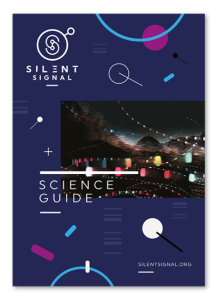“We are the body. We are under attack.” And so the body’s immune system is triggered into action. A raging battle has begun between pro and anti-inflammatory forces in the plasmic swirling interior of a blister.
Each sequence in Battle of Blister has been generated by human performers in an interactive film set. These animations chart the escalation from fly bite to full scale engagement. Spreading, swelling, burning, fighting… capturing the complex dynamics of inflammation; the never-ending battle between bacteria and the body.
As part of the Silent Signal commission, Genetic Moo organised three Blister Cinema events, two in Margate and one in Cardiff. These interactive film sets were designed to generate animated footage for Battle of Blister.
Genetic Moo
Genetic Moo build living installations in pixels and lights. Since 2008, they have been developing a series of interactive video installations based on imagined future evolutions. In darkened spaces audiences engage with their fantastical creatures which combine elements of the human and the animal. Their work draws broadly from science, particularly in the areas of evolution, symbiosis, morphology, phylogeny, mutation and artificial life.
Their work, Starfish, received a John Lansdown Award for Interactive Digital Art at Eurographics in 2007 and was nominated for an Erotic Award in 2012. They were recipients of the Lumen Prize Founder’s Award in 2013, awarded to artists whose work best reflects the uniquely engaging aspects of digital art.
They are currently working on Microworld: an experiment in creating digital ecosystems, where artworks react to each other, to the space and to the audience.
Dr Neil Dufton
Dr Neil Dufton began his scientific career after graduating in Pharmacology from the University of Bath and obtained his PhD in innate immunology and the resolution of inflammation at the William Harvey Research Institute (WHRI), Queen Mary University of London. He spent two years working with Professor John Wallace at the Farncombe Family Digestive Health Research Institute, McMaster University, Hamilton, Canada, investigating the role of hydrogen sulphide gas in regulating inflammation.
Currently, he is a postdoctoral research associate at the National Heart and Lung Institute (NHLI) at Imperial College Londonwith Dr Anna Randi. His research investigates the roles that genes, proteins and gases play in regulating the body’s response to inflammation.
Neil created a website to showcase his artistic and scientific capabilities, and aims to present current scientific knowledge through his abstract and surreal illustrations, some of which have been published in international publications. In 2014, Neil was shortlisted for the British Heart Foundation’s Reflections in Research Image Competition.
INTERVIEWS
Hear from the artist and scientist about their collaboration, their individual interests, and the science behind the collaboration.
SCIENCE GUIDE

Find out more about the science behind the collaboration, with glossary terms, activity sheets and information about the research that inspires the film.

